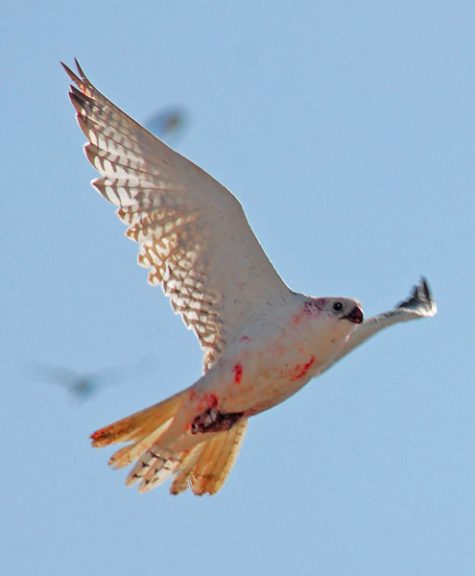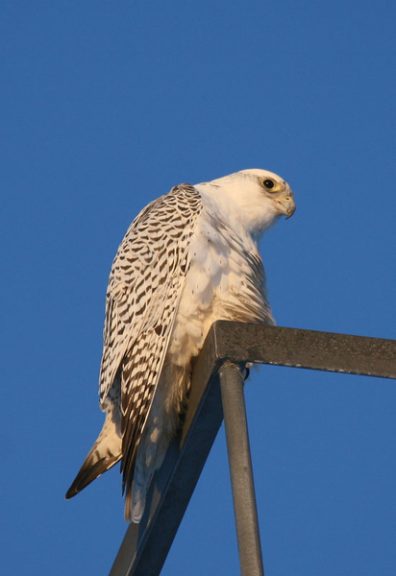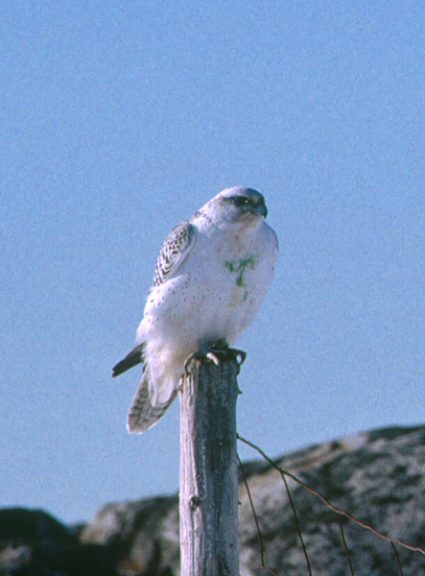Gyr Falcon
Falco rusticolus

Bloody Gyr Flacon, white morph. Young Sound, East Greenland.
The Gyr Falcon is the largest falcon in the world. The plumage varies in colour from almost white over gray to dark. There is no genetic difference bewteen the different morphs, and young form the same clutch can vary form light to dark.
In Greenland the darkest individuals tend to breed in the sub arctic areas in South Greenland. In the low arctic areas most falcons are grey and north of Uummannaq and Scoresby Sound almost all birds are white.
Yong Gyr Falcons are darker and browner than adults, and is distinguished by bluish cere and and bill, and a darker tail. Gyrfalcons will attain the adult plumage at the age of 3 years. They display yellow bill, cere and legs, and a white tail and almost white head. The white falcons cannot be confused with other raptors.
Wingspan: 109-134cm, females being larger than males. Length: 53-63cm. Weight: males 1180g and females 2100g. Wings are pointed and the flight is strong with profound wing beats and levelled wings when gliding.
Compared with Peregrine, which is widely distributed as a breeding bird in Greenland, Gyr Falcons are heavier, have broader wings, display less contrasting head patterns and almost lack of the moustachial stripe.
Life expectancy
Only about 50% of the juvenlies survive the first living year. Once adult, Gyr Falcons average life span is 8-10 years. An Icelandic Gyr Falcon has the record in the nature reaching 12 years and 11 months. In captivity they may reach the age of 30 years.
Food
The preferred food varies according to food availability. In large parts of Greenland the food consists of sea birds hunted in the coastal breeding colonies. In inland ares Rock Ptarmigans and hares are main targets. In autumn migrating passerines like Snow Buntings, Lapland Longspurs and Common Redpolls are most important. In winter seabirds and Rock Ptarmigan are most omportant. Larger birds like Common Eider, Loons and Geese as well as fox puppies may also fall as prey. In Northeast Greenland Lemmings make up an important share of the food.

Old Gyr Flacon, white morph. Photo: Lars Maltha Rasmussen.
Breeding
Gyr Falcons may breed first time as two years old, but usually at the age of 3 or 4 years. They may skip breeding after hard winters and springs with lack of food. The nest is placed on a ledge, and the same nest can be reused for decades. Egg laying in Greenland is usually around 1st of April. Clutch size 3-5 eggs. The females incubate for 35 days while the male provide for the female. After about 50 days in the nest the young will fly at the end of July, but are still fed for another month.
Distribution and breeding numbers
Gyr Falcons are widely distributed as breeding birds in Greenland, as well as in Iceland, in Scandinavia across northern Europe and Asia to Bering Strait, in Alaska and Northern Canada. In Greenland Gyr Falcons most numerous in West Greenland. Southern breeders are sedentary while birds from the north tend to migrate south in winter.
The Greenland breeding population is estimated in the range of 225 to 500 pairs.

Young Gyr Flacon. Foto: Lars Witting.
Research and management
American scientists have studied Gyr Falcons for a number of years in an area in West Greenland. Many aspects of their biology as food, reproduction, nesting success etc. have been studied. Read more here.
Gyr Falcon is totally protected in Greenland. Return dead birds found in the nature to Greenland Institute of Natural Resources. Read about a gyrfalcon that was rescued.
The birds will be examined to determine the coarse of death and the levels of contaminants.
Gyr Falcons are vulnerable to disturbances near the nest at the start of the breeding season from end March to end July were extended disturbances may cause the birds to leave the nest.
Author: Lars Maltha Rasmussen

